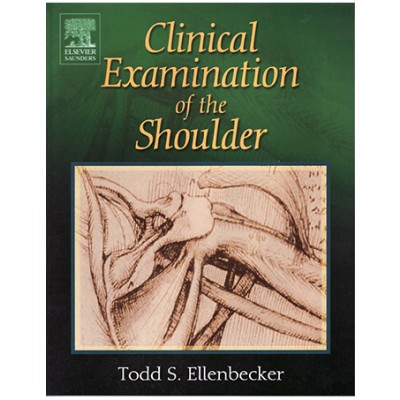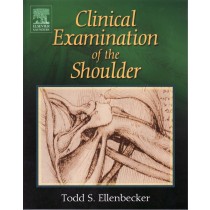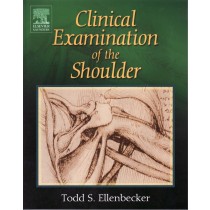
Clinical Examination of the Shoulder
SKU: 721
By: Todd S Ellenbecker, MS, PT, SCS, OCS, CSCS
This course is offered in cooperation with Elsevier Science and includes the hardback textbook, "Clinical Examination of the Shoulder", c2004 by Todd S Ellenbecker, MS, PT, SCS, OCS, CSCS. This exciting new course gives the student a valuable tool for assessing shoulder dysfunction. In addition to instability, impingement, labral, rotator cuff and biceps tests, the course also covers strength testing, subject rating scales and a complete analysis of sports techniques. The course discusses new labral and instability tests and discusses the tests with up-to-date references and case studies. This course is must-have reference for physical therapists, occupational therapists and athletic trainers! 210 pages.
Course Length: 8.0 contact hours
Instructional Level: Beginner/Intermediate
Clinical Examination of the Shoulder
Course Goals and Objectives:
Course Goals:
This course is intended to instruct the student through self-paced study of the clinical examination of the shoulder and to instruct the student in special tests for the shoulder to assist in determining pathologies and conditions.
Student Objectives:
At the end of this course the student will be able to:
1. Differentiate between sensitivity and specificity of testing.
2. Identify the value of prevalence and predictive value to testing.
3. Identify the Scapular Plane Position and its influence on testing the glenohumeral joint.
4. Identify the characteristics and clinical signs of “Tennis Shoulder”.
5. Identify observations to be made during a postural evaluation.
6. Identify the components of normal scapular motion.
7. Identify a classification system for scapular dysfunction.
8. Differentiate between proximally derived scapular dysfunction (PDSD) and distally derived scapular dysfunction (DDSD).
9. Identify 8 special tests for the scapulothoracic joint.
10. Identify potential systemic causes of shoulder pain.
11. Identify 3 special tests for the acromioclavicular joint.
12. Identify 3 special tests for the elbow.
13. Identify the 3 structures present in the thoracic inlet.
14. Identify 4 special tests for thoracic outlet syndrome.
15. Identify 6 special tests for humeral head translation.
16. Identify 3 primary factors glenohumeral joint instability tests rely on.
17. Identify the difference between laxity and instability of the humeral head relative to the glenoid.
18. Identify the most common type of anterior and posterior dislocation in the shoulder.
19. Identify the Neer Stages of Impingement.
20. Identify 6 special tests for rotator cuff impingement.
21. Identify 6 special tests for rotator cuff tears.
22. Identify 5 special tests for the biceps.
23. Differentiate between Bankart and SLAP lesions of the shoulder.
24. Identify 9 special tests for shoulder labral testing.
25. Identify 8 rating scales for the shoulder.
26. Identify the differences between kinesthesia, stagnosia and dynamaesthesia.
27. Identify the concept of proximal-to-distal sequencing.
28. Identify the 4 phases in the overhead throwing motion.
29. Identify the 3 primary phases of tennis forehand and backhand groundstrokes.
SKU: 721
By: Todd S Ellenbecker, MS, PT, SCS, OCS, CSCS
This course is offered in cooperation with Elsevier Science and includes the hardback textbook, "Clinical Examination of the Shoulder", c2004 by Todd S Ellenbecker, MS, PT, SCS, OCS, CSCS. This exciting new course gives the student a valuable tool for assessing shoulder dysfunction. In addition to instability, impingement, labral, rotator cuff and biceps tests, the course also covers strength testing, subject rating scales and a complete analysis of sports techniques. The course discusses new labral and instability tests and discusses the tests with up-to-date references and case studies. This course is must-have reference for physical therapists, occupational therapists and athletic trainers! 210 pages.
Course Length: 8.0 contact hours
Instructional Level: Beginner/Intermediate
Clinical Examination of the Shoulder
Course Goals and Objectives:
Course Goals:
This course is intended to instruct the student through self-paced study of the clinical examination of the shoulder and to instruct the student in special tests for the shoulder to assist in determining pathologies and conditions.
Student Objectives:
At the end of this course the student will be able to:
1. Differentiate between sensitivity and specificity of testing.
2. Identify the value of prevalence and predictive value to testing.
3. Identify the Scapular Plane Position and its influence on testing the glenohumeral joint.
4. Identify the characteristics and clinical signs of “Tennis Shoulder”.
5. Identify observations to be made during a postural evaluation.
6. Identify the components of normal scapular motion.
7. Identify a classification system for scapular dysfunction.
8. Differentiate between proximally derived scapular dysfunction (PDSD) and distally derived scapular dysfunction (DDSD).
9. Identify 8 special tests for the scapulothoracic joint.
10. Identify potential systemic causes of shoulder pain.
11. Identify 3 special tests for the acromioclavicular joint.
12. Identify 3 special tests for the elbow.
13. Identify the 3 structures present in the thoracic inlet.
14. Identify 4 special tests for thoracic outlet syndrome.
15. Identify 6 special tests for humeral head translation.
16. Identify 3 primary factors glenohumeral joint instability tests rely on.
17. Identify the difference between laxity and instability of the humeral head relative to the glenoid.
18. Identify the most common type of anterior and posterior dislocation in the shoulder.
19. Identify the Neer Stages of Impingement.
20. Identify 6 special tests for rotator cuff impingement.
21. Identify 6 special tests for rotator cuff tears.
22. Identify 5 special tests for the biceps.
23. Differentiate between Bankart and SLAP lesions of the shoulder.
24. Identify 9 special tests for shoulder labral testing.
25. Identify 8 rating scales for the shoulder.
26. Identify the differences between kinesthesia, stagnosia and dynamaesthesia.
27. Identify the concept of proximal-to-distal sequencing.
28. Identify the 4 phases in the overhead throwing motion.
29. Identify the 3 primary phases of tennis forehand and backhand groundstrokes.



